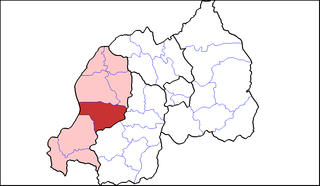| Mbirurume River | |
|---|---|
| Country | Rwanda |
| Physical characteristics | |
| River mouth | 2°12′18″S29°33′36″E / 2.204875°S 29.559917°E Coordinates: 2°12′18″S29°33′36″E / 2.204875°S 29.559917°E |
| Basin features | |
| River system | Nyabarongo River |
The Mbirurume (also called Bilirume, Biruruma, Birurume, Bitirume) is a river in western Rwanda that is a tributary of the Nyabarongo River.

Rwanda, officially the Republic of Rwanda, is a country in Central and East Africa and one of the smallest countries on the African mainland. Located a few degrees south of the Equator, Rwanda is bordered by Uganda, Tanzania, Burundi, and the Democratic Republic of the Congo. Rwanda is in the African Great Lakes region and is highly elevated; its geography is dominated by mountains in the west and savanna to the east, with numerous lakes throughout the country. The climate is temperate to subtropical, with two rainy seasons and two dry seasons each year.

The Nyabarongo is a major river in Rwanda, part of the upper headwaters of the Nile. At 297 km, it is the longest river entirely in Rwanda. The river begins its course at the confluence of the rivers Mbirurume and Mwogo in the South West of the country. These two rivers themselves begin in Nyungwe Forest, and are considered by some to be the most distant source of the Nile. From its start, Nyabarongo flows northward for 85 km, and forms the border between the Western and Southern Provinces. At the confluence with the river Mukungwa, the river changes course and flows eastward for 12 km, then to a more South Eastern course for the last 200 km. For the longest stretch of this course, the river serves as the boundary between the Northern and Southern Provinces, then between the City of Kigali and the Southern Province, and lastly between the City of Kigali and the Eastern Province. The river then before enters the Eastern Province and ends its course close to the border with Burundi. The Nyabarongo River empties both in Lake Rweru and Akagera river in a small but complicated Delta. The Akagera river outflows from Lake Rweru, a mere 1 km from the Nyabarongo delta. Almost all the branches of the Nyabarongo delta empty in the lake, however, one branch of the delta empties directly in the just formed Akagera river. The Akagera River eventually flows into Lake Victoria and forms the Nile.
The Mbirurume rises in forested country in southern Rwanda to the east of the Congo-Nile Divide. [1] It originates in the extreme north of the Nyungwe National Park, in the Nyamagabe District. It flows in a northeast direction, entering Karongi District and passes Mukungu to the west, then runs in a northeast direction along the border between Nyamagabe and Karongi districts. It then turns southeast shortly before meeting the Mwogo River from the left. [2] [3] The combined rivers form the Nyabarongo River, which flows northward along the eastern slopes of the Nile-Congo divide. [1]

The Congo-Nile Divide region of Rwanda and Burundi is a mountainous area in the southern section of the Congo-Nile Divide, to the east of the Albertine Rift. The region includes the Nyungwe and Kibira national parks. The Bugoyi people live in the region.

Nyamagabe is a district (akarere) in Southern Province, Rwanda. Its capital is Gasaka.

Karongi is a district (akarere) in Western Province, Rwanda. Its capital is Rubengera, but the district also contains Kibuye, Rwanda, the provincial capital and a major Rwandan lakeside resort.










